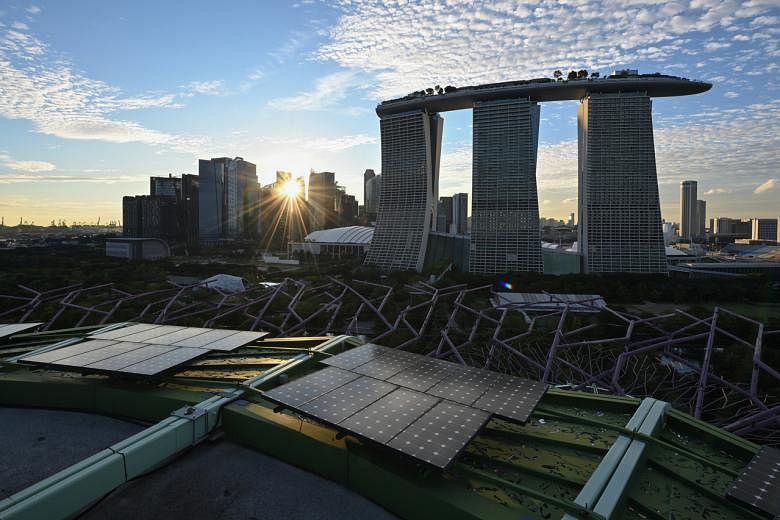SINGAPORE - Green standards will be set for power generation companies by the Energy Market Authority (EMA), as part of the nation's efforts to reduce its carbon footprint, Second Minister for Trade and Industry Tan See Leng said in Parliament on Tuesday (Nov 2).
Under the amendments to the Energy (Resilience Measures and Miscellaneous Amendments) Bill on Tuesday (Nov 2), EMA will be able to implement policies and strategies to reduce greenhouse gas emissions in the import, export, generation, transmission and supply of electricity.
This comes as Singapore still depends heavily on natural gas - a type of fossil fuel - to provide more than 95 per cent of its current electricity demand.
Natural gas continues to be needed even as Singapore turns to low-carbon sources of energy such as solar energy, and regional power grids, and low-carbon alternatives such as hydrogen to decarbonise the nation's electricity grids.
The latest move will also add regulatory teeth to EMA's existing incentive schemes, such as the energy efficiency grant, to get power generation companies to improve their energy efficiency and shift towards cleaner and more efficient modes of power generation.
During the debate on the Bill, MPs asked about the proposed timeline for the new standards and policies to be released to power generation companies, and for updates on Singapore's long-term plans to decarbonise its energy sources.
Mr Louis Ng (Nee Soon GRC) wanted to know EMA's timeline for consulting the energy sector and releasing new standards of policies, as power generators will need time to adapt to the new regulations.
He also asked if the Ministry will proactively share with the public the expected emissions impact of any new power-generation projects.
In response, Dr Tan reiterated that EMA is committed to decarbonising the power sector, using a combination of "broad-based regulatory measures and targeted support measures".
He added that the first iteration of the new greenhouse gas standards will be released for public consultation as early as 2022, and that EMA will ensure the standards are "reasonable and realistic but also ambitious".
Companies will be given time to transition, and the public can monitor EMA's progress in decarbonising the power grid via the Grid Emissions Factor report published on EMA's website yearly, said Dr Tan.
Several MPs also pointed out the difficulties in diversifying Singapore's current reliance on natural gas, and asked for updates on how the nation will be shifting to renewable energy in the future.
Mr Gerald Giam (Aljunied GRC) stressed the need to strengthen indigenous capabilities to produce clean energy, as more countries turn to natural gas as a transition fuel.
On the solar front, Mr Giam asked if Singapore is planning for a large-scale deployment of solar panels, and if companies are given sufficient incentives to boost the adoption of energy storage systems.
He also called on the Government to innovate and come up with more clean energy solutions to diversify Singapore's energy mix and explore other renewable sources like tidal energy, geothermal energy and offshore wind farms.
Ms Cheryl Chan (East Coast GRC) noted that while diversification has long been a "cornerstone" in Singapore's policy on resources be it water or energy, it will be difficult to switch to alternative supplies from natural gas in the coming decades.
She asked if there are opportunities in the longer term to focus on how carbon capture capabilities, storage or utilisation can be shared cross-border or developed in locations where underground geologic formation permit.
Other MPs also asked when hydrogen will likely be commercially viable for use, and if nuclear power will be included in Singapore's energy mix.
Dr Tan said Singapore will go beyond diversifying the types of energy that it uses by also diversifying the geographical sources of energy to manage political and security risks.
He added that Singapore lies in a region with abundant renewable energy potential, and all companies keen to collaborate on the development of renewable energy sources can participate in the EMA's requests for proposal for electricity imports.
Dr Tan also said Singapore is investing heavily in research and development to understand the potential for low-carbon technologies.
"Our current assessment is that hydrogen will only be commercially viable around 2040. However, many countries are investing heavily in lowering the cost of producing ,transporting, storing and using hydrogen," he added.
He said EMA and the Ministry for Trade and Industry are also looking at energy that can be produced in Singapore - including the use of geothermal energy and accelerating the deployment of solar energy, notwithstanding Singapore's limited potential.
"As for nuclear energy, while there have been advancements in nuclear reactor technologies, which may have the potential to improve the safety of nuclear generation, many of these are still in the research and development phase and they have not begun commercial operations," said Dr Tan.
He added that Singapore will continue to monitor these technologies while strengthening capabilities to understand nuclear science and technology.


